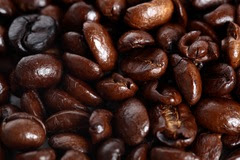In my fours years as a professional roaster, I have learned that coffee drinkers are creatures of habit. Like robots, we stumble from bed to the stove or the coffeemaker, where we prepare the stimulant that launches our senses and starts our days. For many people, the brand and style of coffee has been the same for years, as has the style of preparation and often the cup in which it is consumed.
Among these habits is for many the standard that all coffee must be dark-roasted. I know this habit all too well, having been nursed with a steady diet of Peets from my teens until I moved east.
But I confess now that when someone tells me they are a “dark roast drinker”, this elicits a feeling somewhat akin to pity. I want to give that person a hug, guide them to a quiet place to rest and listen to their troubles.
But really what I want to do is convert them to all the wonders of coffee that are out there for those who drink their coffee at a lighter roast level. I want them to sit down in my pew, drink my kool-aid and read my little comic books about how repent and change their ways.
Perhaps I need to see someone about this?
Dark roasted coffee is ultimately a food that some prefer cooked more than others. This puts it in the same class with well-done meat, muffin tops, dark beer, caramel, cooked carrots and braised radicchio. It is not bad, just different.
Starbucks has built their whole corporation around dark roasted coffee, but in large part their coffee needs to be roasted this way so that it can be detected when served with large volumes of milk. I was amused recently to see that they just introduced Starbucks Blonde, in recognition of the (by their count) more than 40% of coffee drinkers that prefer a lighter roast. The company was founded in 1971, so it is funny that it took over forty years to come to this realization. Let me see, 40 years times $12 billion (annual sales) times 40% (amount of lost revenue due to dissing light roast drinkers) equals roughly $192 BILLION dollars in lost money due to an obsession with dark roasted coffee.
Is it worth it, I ask you?
What is Dark Roasted Coffee?
In my roaster, there is a probe (metal rod) that extends into the swirling bed of roasting beans that gives me a digital readout of the current temperature of the coffee as it progresses through the roasting process. I use this information, along with a visual inspection of the coffee, to evaluate the coffee as it roasts and the point at which stop the process and drop the coffee into the cooling bin. My choices of these temperatures (and visual state of the coffee) determine the “degree of roast” of the coffee in a spectrum from light to dark.
For those who know our coffees, here are examples of the numbers I see on this readout:
* 425: The preheated roaster before I put any coffee into it.
* 200: The lowest number I see during the roast process when the temperature of the room temperature coffee I added to the roaster equalizes with the heat of the roaster.
* 375: The start of the “first crack” (an expansion of the bean caused by the release of steam and CO2)
* 412: Stopping point for a light roasted coffee such as an Ethiopia Sidamo
* 418: Stopping point for medium-roasted coffees like our Honduras or Guatemala
* 428: Stopping point for our current espresso blend; “second crack” starts here (a fracturing of the cell wall of the coffee beans)
* 440: Stopping point for our Indo-Limbo French Roast
Sweet Marias provides an excellent visual guide to the roasting progression here.
The flavor dynamic dark roast lovers enjoy is that of caramelized sugar brought on by darker roast levels. These tastes are very much analogous to those of caramel candy, which begins as white sugar and then attains a darker color as these chemical changes occur, or dark beer, where barley (or other grains) are taken to darker levels in the malting process.
The dark roasting progression also introduces mild to severe burnt tastes to the coffee, and causes the oils in the bean to rise to the surface (causing it to stale faster, by the way). In addition, dark roasting expands the coffee a lot, so you will note that a pound of our Indo Limbo takes up a lot more space than a pound of our Honduras.
Let there be Peace
You know those Thanksgiving dinners where the turkey comes around the table on a platter, and you take a little white meat and a little dark too? And you enjoy them both?
Well shucks, let’s do the same thing with coffee.
For you lofty light roast drinkers (um . . . myself included), give the dark side a break. Understand that there is good dark roasted coffee to be had out there, and that, done properly, these roast levels can still reflect plenty of origin character and nuances of the coffee. REALLY understand (please) that the term “espresso” is not synonymous with “carbon” and that light or medium roasted espresso can taste really awesome and not burnt at all.
And those from the noir side of the aisle, you aren’t on an island, stuck there in Darkroastlandia with nowhere to turn. There is a world of coffee out there waiting for you, if you would only give it a chance. Don’t start your voyage off the island by drinking a delicate light roast, as you are likely to think of it as weak, tea-like or sour. Seek out coffees with a fuller, bolder taste like a nice medium roasted Sumatra or African, and work your way down from there.
Coffee is too great and too diverse to be polarizing. Enjoy the ride.

